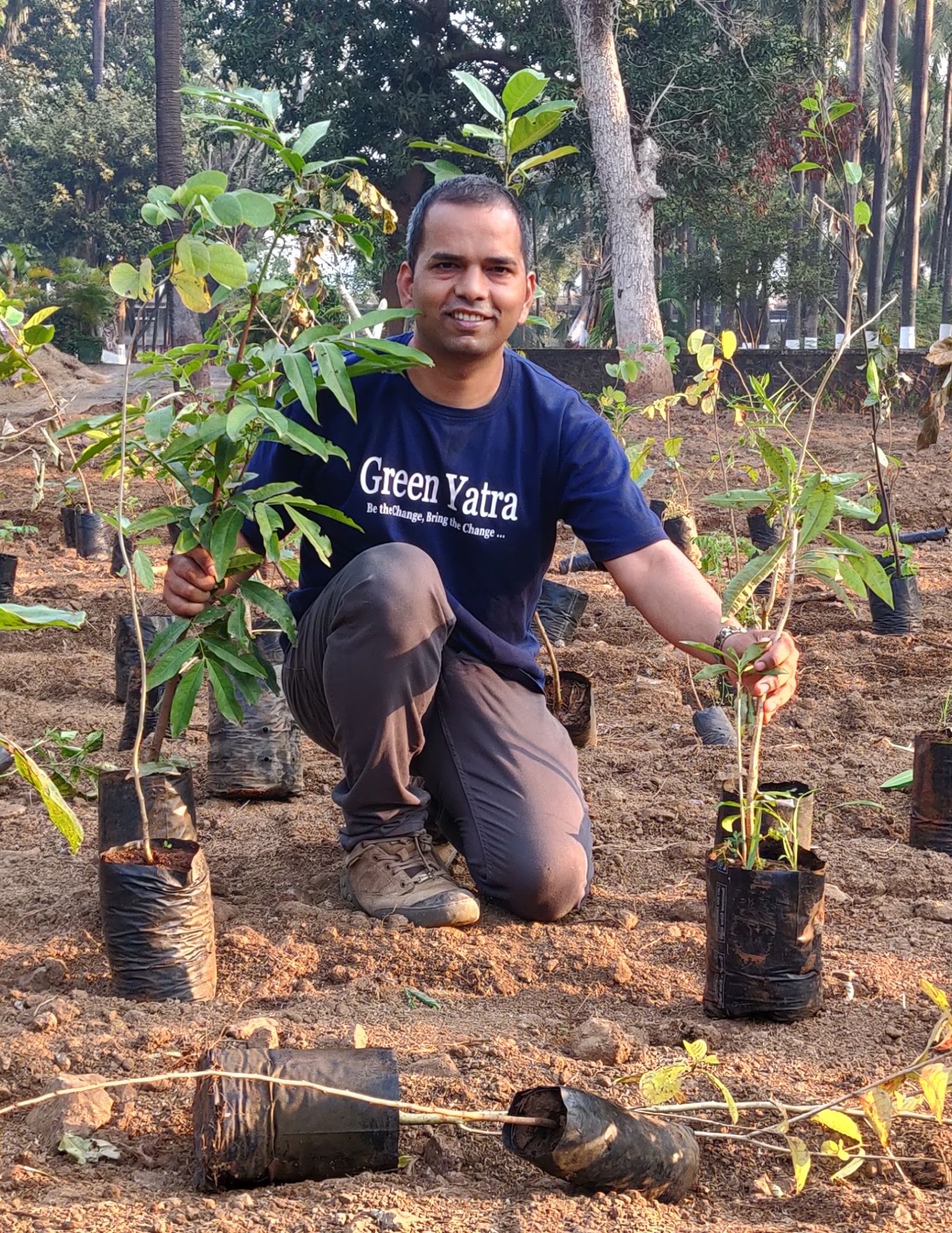
Mr. Durgesh Gupta, lawyer of the Indian Supreme court has been consistently working for the betterment of the environment since the last decade. He is the founder of Green Yatra, one of India’s most prominent NGO and is a global campaigner for climate change. He and his team created India’s first Miyawaki forest in Mumbai.
Miyawaki is an innovative plantation method invented by Japanese botanist and plant ecology expert Dr. Akira Miyawaki. The Miyawaki method is a unique “Potential Natural Vegetation” concept, proven to work worldwide, irrespective of soil and climatic conditions. More than 3,000 forests have been successfully created worldwide using this methodology.
A short introduction Miyawaki method of forestation
Forests grown under Miyawaki method grow 10 times faster, 30
times denser, 100 times more biodiversity, 30 times better Carbon-dioxide
absorption, 30 times better noise and dust reduction, 30 times greener
surface area, as compared to a monoculture plantation. So, we get a 100% native,
100% organic and 100-year-old forest in just 10 years. In this method we
plant minimum 20 – 50 different local and native species plants in a small
patch of land. Multi-layered 2-3 feet saplings are planted very closely; 2-5
saplings per square meter. These 2-3 feet saplings can grow up to 20 feet
grown tree in just 2 years (PFA reference pictures) .There is
no use of any type of chemicals and chemical
fertilizers. The best part of this method is that one will get a
completely maintenance-free, wild, organic, natural and native dense forest in
just two years. This dense forest not only increases green cover but also
curbs down air pollution to retain more
groundwater, recharge the groundwater table and support local bio-diversity.
The metropolitan cities like Mumbai, which are slowly converting into a
concrete jungle where the number oftrees per person in the city is very low and
decreasing every year, plantation space is a big issue. We need a solution,
which can bring exceptional results in less space and ample time and Miyawaki
method of the plantation is the answer. In this method, one can grow ultra-fast
growing dense forests in small patches in the different places of the city
as residential housing societies, gardens, Industrial areas, corporate and IT
parks, MIDC areas and such other places. It requires minimum 1000 square feet
patch of land to grow a tiny Miyawaki forest.
Sustainable solutions project
Sustainability – The ability to meet the needs of the present generation without compromising the needs of the future generations.
As many leading organizations take the step to a green world for a better future, green workspaces can play a major role in it. Sustainable Solutions enables a company to become a Green Company. It is a simple, well-planned, strategic, scientific database and analytical audit process of Water, Energy, Waste and Carbon footprint and provides best possible strategy to mitigate these issues. The whole practice saves one’s valuable money along and also has positive impact on society and our planet Earth.
Mr.Durgesh Gupta has been awarded for the Miyawaki award for planting Miyawaki forests and has been mentioned in RCVJ’s social media page. He has also been awarded the REXKaramveer Global Fellowship and Karamveer Chakra Award instituted by ICONGO and UN. At this point, our world and especially India needs more people like Mr.Gupta.
Green yatra Q&A
1.Could you please elaborate on how you started your journey with Green Yatra?
Ans: As being an Environmentalist, I chose to start my journey with Green Yatra as I wanted to work towards the betterment of the environment. We started our journey with one project called Go Green Ganesha and after its success we started many other Environment impact projects for welfare of society. Here in Green Yatra, we use different conservation and protection strategies along with spreading awareness among the youth, as you know, they are the current face of our nation. We work on spreading awareness regarding conservation of energy, water and wildlife to protect it from any further harm.
2. In what way you are affecting the young minds of this nation to conserve energy, environment and water so that the next generation does not have to face hardships?
Ans: As I told you, Green Yatra believes in spreading awareness among the youth, our project named ‘Go green Kids’ in which we approach schools and teach the kids how to apply ‘go green’ strategy in their day-to-day lives. For example, we tell them to switch off all the electronic gadgets whenever they are leaving any room or going out of the home. Also, checking on taps so that that there are no water leakages, banning the use of plastics; in this way, they can protect the environment.
There is also a ‘Green committee’ in the school which is in charge of taking care of the workshop arranged by us. Kids nowadays are coming up with great ideas to conserve electricity such as by spending fewer hours in front of the TV. This has also helped in uplifting the parent-child relationships as well. Many schools take written exams in which the kids portray what difference he has created towards saving energy or sharing innovative ideas and accordingly marks are allocated to based on best answers, this again inspire students tobe more responsible towards the Environment.
3. Can you tell us about Green Yatra’s vision?
Ans: Green Yatra was founded in Mumbai in 2009 and registered in the year 2010. It’s been 10 years and Green Yatra has able to spread across the major cities in India like Mumbai, Pune, Ahmedabad, Kolkata, Delhi/NCR, Indore, Jaipur, Bengaluru and etc. and we hope to extend in all-over India very soon. We have started many initiatives like ‘Pedh Lagao’, ‘Bag for cause’, ‘Zaroorat’ which focus on planting trees, training underprivileged women to stitch non-plastic bags, cloth and accessories donation drives respectively. So, if I tell you about the vision, it is basically to make India Clean and Green as air/water pollution has caused many deaths in India and everyone is suffering irrespective of rich or poor.
4. I’d like you to share a small, impactful message to the youth, which can help to generate more awareness.
Ans: I’d like to tell the youth that please try conserving the electricity, water and environment at least at your home first or the area where you stay; as we all know, charity begins at home. Educate your near and dear ones to follow these steps. This good work will pay off someday. Just keep doing the good work.
5. What do you consider to be the most serious environmental threat in the world and specifically in India?
Ans: The most serious environmental threat in the world is global warming and pollution. In addition, excessive use of plastics and improper disposal of waste are serious perils. In India, overpopulation which leads to excessive use of resources, deforestation due to increasing demand for wood, construction materials and land for building construction are significant risks .
6. What are some small steps we can take to save the environment?
Ans: As individuals, there is a lot we can do. Follow the three R’s: Reuse, Reduce, Recycle. We can use reusable articles, opt for car-pooling instead of private cars, use bicycles for short distance travels. We can begin by saving electricity and conserving water as much as we can. We need to stop wasting paper and of course, plant trees. Start Upcycle culture. Keep inspiring other through social medias the work you did for environment and inform them to follow you.
7. What is India’s current status with respect to spreading awareness and dealing with environmental issues?
Ans: There is not much awareness about the environmental issues in India. There is a lot to do to control overpopulation, overuse of resources and deforestation. Thankfully, due to the presence of social media, there has been much awareness about rising environmental issues and now, people are dealing with environmental issues with as much seriousness and attention as it deserves.
8. How far can technology help to save the environment?
Ans: I would say technology and social media has been of much help to spread consciousness about serious environmental issues. People are actually talking about how important it is to save the environment for our future generations and ourselves. People are using social media to promote various Go Green Campaigns. So yes, technology can help a lot to generate alertness around the environmental issues.
9. What harmful steps are we taking that are ultimately resulting in the degradation of the environment?
Ans: Excessive use and destruction of Natural resources including plastic bags is one of the main causes of environmental degradation, which we, as common people are responsible for. Use of private cars for short distance travel and improper waste disposal ultimately result in the degradation of the environment. Wasting paper, water and electricity are also major steps towards environmental disintegration.
10. Can you briefly tell us about your campaigns and how successful they have been?
Ans: Starting with “Rural Livelihood Plantation under our flagship project Pedh Lagao”, we planted nearly 1 million livelihood fruit trees across rural areas in Mahrashtra and Other states. In the “Bag for Cause” Campaign, we began to run training centres across Bhiwandi and Ambadi to train tribal and underprivileged women stitch non-plastic bags thereby solving dual purpose of plastic free environment and providing employment to the needy. “Zaroorat”, based on the philosophy of ‘One man’s waste can be other man’s need’, encourages people to donate old clothes, utensils electrical appliances bed sheets, toys, blankets, shoes, sporting goods, furniture, stationery, books so that it may distribute the same to those in need after being packaged, repaired and sewed.Under ‘Go green Kids’ project we approach schools and teach the kids how to apply ‘go green’ strategy in their day-to-day lives. All the initiatives have been successful to achieve their cause and create a better environment. Under our Sustainable solutions project we cater to meet the needs of the present generation without compromising the needs of the future generations. Our Pedh Lagao पेड़लगाओproject is dedicated to plant #10CroreTREESby2025 PAN India metro cities throughout the year and help them to be a mature tree. Our Project Jal works towards Water Conversation, Sustainable Villageproject main object is to stop migration & make it sustainable in all aspect the said village. Green Campus project we promote change through theory and practical implementation of green concepts. Under Annual Green Tutorial workshop we provide various innovative tutorials & workshops to educate, execute green actionable steps and have fun In orderto succeed in achieving sustainability goals.Green Celebration object is to Plan a Green party – save the environment and money and last but not least our Miyawaki Urban Forest which has object to create Dense Urban Forest In Less Time And Less Space.
Please click here to read the full magazine. https://monomousumi.com/weaver-volume-9/


